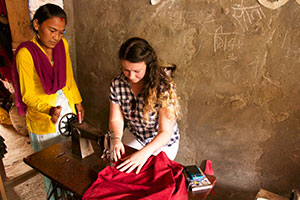What we learned from our study of development projects in Nepal
Joshua Page
Public relations assistant
Avondale College of Higher Education
Kathmandu, Nepal
Everest. Sherpas. The world’s only non-quadrilateral flag. The country: Nepal, of course. The nine Avondale College of Higher Education students who visited June 17-July 15 learned much more about this landlocked nation, though. Rough roads, raging rapids. Patriarchy, poverty. The caste system, climate change. And a vulnerable but proud people fighting for a better life.

A small business owner teaches Emma McCrow to use a manual sewing machine in Ghanjaripipal village, Nepal. Credit: Alexandra Radovan.
The trip served as the practical component of one of our international poverty and development studies units. We’d previously completed other units in the course and prepared extensively throughout first semester for the trip. During our month in Nepal, we traversed 19 of its 75 districts to visit 15 villages, all beneficiaries of Adventist Development and Relief Agency (ADRA) projects.
The field work took a different form from most short-term mission trips: we were monitoring and evaluating completed ADRA projects. It doesn’t sound as exciting as building a church or a school, and in some ways, it wasn’t. But as senior lecturer Brad Watson says, “It’s much harder engaging in a process where someone else is feeling like they’re the ones who ‘did it,’ and those foreigners were only tangental. As a feel-good activity, it doesn’t work as well as other experiences, but it is providing an important service.”
While the projects we evaluated were funded in Australia, our feedback would join a large body of research being presented to the British government’s UK Aid. The kicker: we could influence millions of dollars of humanitarian funding. “Take it seriously, because ADRA takes it seriously,” advised Simon Lewis, the ADRA Nepal country director at the time.
Throughout our travels, we found ourselves irresistibly drawn to the people of Nepal and their stories. Our translator, for example: a career woman in a patriarchal society. Malnourished eight-year-old twins overlooked in a reasonably prosperous village, and the challenge to provide help for them that would continue after we departed. Nepal’s only all-female adventure company, with glowing hope for the future. An ambitious young man soon to become the first person in his village to hold a tertiary degree. Another man who asked us to tell our government to stop polluting, as we were causing climate change in his village. A confident women’s group who excitedly told us that as microcredit programs gave them income, their husbands gave them respect.
These people are the real Nepal—no less a part of the country than the stones and snow of Everest. We went to help and were gratefully received. But we learned, too. We learned many fail to break the cycle of poverty because they simply lack the opportunity to do so. We learned to hope and to strive for a world where we can offer these opportunities to all.
